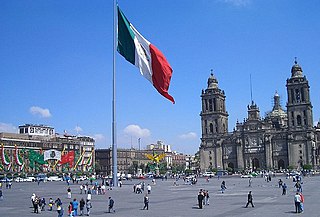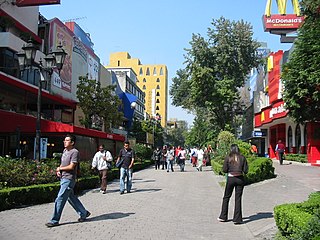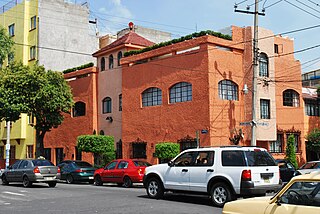Colonia Santa María Insurgentes is a colonia in the Cuauhtémoc borough north east of the Mexico City’s historic center. The colonia’s borders are formed by the following roads: Calzada de San Simon to the south, Jacarandas to the north, Avenida de los Insurgentes Norte to the east and Jacarandas to the west. [1]
In general, colonias are neighborhoods in Mexican cities, which have no jurisdictional autonomy or representation. It is plausible that the name, which literally means colony, arose in the late 19th, early 20th centuries, when one of the first urban developments outside Mexico City's core was inhabited by a French colony in the city. Usually colonias are assigned a specific postal code; nonetheless, in recent urban developments, gated communities are also defined as colonias and share the postal code with adjacent neighborhoods. In spite of this, the name of the colonia must be specified when writing an address in large urban areas in Mexico.

The historic center of Mexico City, also known as the Centro or Centro Histórico, is the central neighborhood in Mexico City, Mexico, focused on Zócalo or main plaza and extending in all directions for a number of blocks, with its farthest extent being west to the Alameda Central. The Zocalo is the largest plaza in Latin America. It can hold up to nearly 100,000 people.
The official establishment of the colonia occurred in 1910, but there had been named streets and laid out blocks for some time before this. The land here belonged to the El Chopo Ranch before much of it was sold and eventually subdivided. The government order establishing the colonia mandates the conservation of the layout and street names. However, the colonia did not receive its name until 1950, when it was expanded. The area was originally conceived to be residential, but much of it became industrial. [1] Today, much of the area is still industrial, with major facilities such as those belonging to Unilever on Rio Consulado. [2]

Unilever is a British-Dutch transnational consumer goods company co-headquartered in London, United Kingdom and Rotterdam, Netherlands. Its products include food and beverages, cleaning agents, beauty products, and personal care products. It is Europe’s seventh most valuable company. Unilever is one of the oldest multinational companies; its products are available in around 190 countries.
Area schools include Cecyt Num. 12, Jose Maria Morelos y Pavon technical school (public), Colegio Bilingue Madison primary (private), and Escuela Secundaria y Preparatoria Justo Sierra, Plantel Azahares (middle and high school) (private) . [3]
The Tren Suburbano commuter line crosses through the colonia as it connects downtown Mexico City with suburbs to the north of the city. Neighbors both in this colonia and neighboring Colonia Atlampa have complained that the train, built in the 2000s, has brought more crime to an area that already has serious problems of this type. They also claim that the rail line causes traffic jams, especially as the trains go over the speed limit and disregard traffic signals on streets such as Geranio, San Simon, Mimosas and Cipres. [4]

Colonia Atlampa is a colonia or neighborhood located in the Cuauhtémoc borough, northwest of the historic center of Mexico City. The boundaries of the area are marked by the following streets: Calzada de Nonoalco or Ricardo Flores Magón Street to the south, Circuito Interior Paseo de las Jacarandas to the north, Avenida Insurgentes Norte to the east and Circuito Interior Instituto Politécnico Industrial to the west. The neighborhood is considered lower class and working class. The name is derived from a Nahuatl phrase meaning "where the water divides."
Even without the suburban train, traffic is problematic in the colonia. One bad intersection, reported by El Universal newspaper, is Eje 2 Norte and Geranio, where micros (small privately owned busses) routinely ignore traffic signals and police are either non-existent. [4] On a number of other roads, driver frequently take shortcuts over roads going against traffic. Streets such as Oyamel, Abedules and Mimosas have many potholes. [4]
El Universal is a major Mexican newspaper.
The colonia has long had crime problems especially from youths as they leave school for the day. Crimes include vandalism, drug use and sales and the stealing of cars. Residents claim that they have appealed to city and federal authorities for help but with no response. [4] The colonia is home to one major tianguis, or open flea market, which is a cultural heritage from the pre-Hispanic era. It is called El Nopal. While it sells food, clothing and other everyday items, it has also been accused of trafficking in arms and other contraband. [5]

A tianguis is an open-air market or bazaar that is traditionally held on certain market days in a town or city neighborhood in Mexico and Central America. This bazaar tradition has its roots well into the pre-Hispanic period and continues in many cases essentially unchanged into the present day. The word tianguis comes from tianquiztli in Nahuatl, the language of the Aztec Empire. In rural areas, many traditional types of merchandise are still sold, such as agriculture supplies and products as well as modern, mass-produced goods. In the cities, mass-produced goods are mostly sold, but the organization of tianguis events is mostly the same. There are also specialty tianguis events for holidays such as Christmas as well as for particular types of items such as cars or art.
The Glorieta de la Raza is located on the extreme northeast of the colonia, and is a large 5-lane traffic circle with the Monumento a la Raza (Monument to the Race) in the center. It is an extremely busy intersection connecting Insurgentes Norte, Vallejo and Circuito Interior arteries. It was originally designed for cars and light trucks but many tractor trailers also use the intersection as well. This and speeding has caused frequent accidents on this circle. [6]













